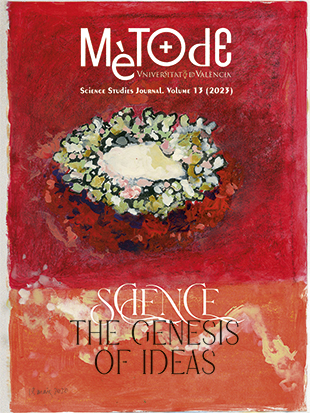Bellesa i elecció de parella: El que la biologia evolutiva ens ensenya
DOI:
https://doi.org/10.7203/metode.13.24205Paraules clau:
bellesa, elecció de parella, evolució, psicologia evolucionista, selecció sexual Resum
Resum
Tendim a considerar la bellesa com el producte destil·lat de la nostra educació, la quinta essencia del nostre refinament cultural. A més, sovint destaquem el relativisme de la bellesa. Per aquest motiu, molts troben xocant que la percepció de la bellesa, especialment la bellesa humana, tinga una clara explicació biològica, en gran manera independent de la nostra educació i cultura, i els sorprèn descobrir que les característiques que defineixen la bellesa no només tenen sentit biològic, sinó que a més són universals, comunes a tots els membres de la nostra espècie.
 Descàrregues
Descàrregues
 Referències
Referències
Bovet, J., & Raymond, M. (2015). Preferred women’s waist-to-hip ratio variation over the last 2,500 years. PLOS ONE, 10(4), e0123284. https://doi.org/10.1371/journal.pone.0123284
Buss, D. (2016). The evolution of desire: Strategies of human mating. Basic Books.
Cloud, J. M., & Perilloux, C. (2014). Bodily attractiveness as a window to women’s fertility and reproductive value. In V. A. Weekes-Shackelford & T. K. Shackelford (Eds.), Evolutionary perspectives on human sexual psychology and behavior (pp. 135–152). Springer. https://doi.org/10.1007/978-1-4939-0314-6_7
Coetzee, V., Greeff, J. M., Stephen, I. D., & Perrett, D. I. (2014). Cross-cultural agreement in facial attractiveness preferences: The role of ethnicity and gender. PLOS ONE, 9(7), e99629. https://doi.org/10.1371/journal.pone.0099629
Cunningham, M. R., Roberts, A. R., Wu, C. H., Barbee, A. P., & Druen, P. B. (1995). “Their ideas of beauty are, on the whole, the same as ours”: Consistency and variability in the cross-cultural perception of female attractiveness. Journal of Personality and Social Psychology, 68(2), 261–279. https://doi.org/10.1037/0022-3514.68.2.261
Darwin, C. (1871). The descent of man and selection in relation to sex. Murray.
Etcoff, N. (1999). Survival of the prettiest: The science of beauty. Anchor Books.
Font, E., & Carazo, P. (2021). False dichotomies and human sexual size dimorphism: A comment of Dunsworth (2020). Evolution and Human Behavior, 42(2), 176–178. https://doi.org/10.1016/j.evolhumbehav.2020.08.003
Grammer, K., Fink, B., Møller, A. P., & Thornhill, R. (2003). Darwinian aesthetics: Sexual selection and the biology of beauty. Biological Reviews, 78(3), 385–407. https://doi.org/10.1017/s1464793102006085
Kenrick, D. T., Keefe, R. C., Bryan, A., Barr, A., & Brown, S. (1995). Age preferences and mate choice among homosexuals and heterosexuals: A case for modular psychological mechanisms. Journal of Personality and Social Psychology, 69(6), 1166–1172. https://doi.org/10.1037/0022-3514.69.6.1166
Langlois, J. H., Kalakanis, L., Rubenstein, A. J., Larson, A., Hallam, M., & Smoot, M. (2000). Maxims or myths of beauty? A meta-analytic and theoretical review. Psychological Bulletin, 126(3), 390–423. https://doi.org/10.1037/0033-2909.126.3.390
Langlois, J. H., Ritter, J. M., Roggman, L. A., & Vaughn, L. S. (1991). Facial diversity and infant preferences for attractive faces. Developmental Psychology, 27(1), 79–84. https://doi.org/10.1037/0012-1649.27.1.79
Miller, G. F. (2000). The mating mind: How sexual choice shaped the evolution of human nature. Vintage.
Muller, M. N., Thompson, M. E., & Wrangham, R. W. (2006). Male chimpanzees prefer mating with old females. Current Biology, 16(22), 2234–2238. https://doi.org/10.1016/j.cub.2006.09.042
Singh D., Dixson B. J., Jessop T. S., Morgan B., & Dixson A. F. (2010). Cross-cultural consensus for waist–hip ratio and women’s attractiveness. Evolution and Human Behavior, 31(3), 176–181. https://doi.org/10.1016/j.evolhumbehav.2009.09.001
Singh, D. (1993). Adaptive significance of female physical attractiveness: Role of waist-to-hip ratio. Journal of Personality and Social Psychology, 65(2), 293–307. https://doi.org/10.1037//0022-3514.65.2.293
Singh, D., & Singh, D. (2011). Shape and significance of feminine beauty: An evolutionary perspective. Sex Roles, 64, 723–731. https://doi.org/10.1007/s11199-011-9938-z
Singh, D., Renn, P., & Singh, A. (2007). Did the perils of abdominal obesity affect the depiction of female beauty in the sixteeth to eighteenth century British literature? Exploring the health and beauty link. Proceedings of the Royal Society of London B, 274(1611), 891–894. https://doi.org/10.1098/rspb.2006.0239
Stewart-Williams, S., & Thomas, A. G. (2013). The ape that thought it was a peacock: Does evolutionary psychology exaggerate human sex differences? Psychological Inquiry, 24(3), 137–168. https://doi.org/10.1080/1047840X.2013.804899
Symons, D. (1995). Beauty is in the adaptations of the beholder: The evolutionary psychology of human female sexual attractiveness. In P. R. Abramson & S. D. Pinkerton (Eds.), Sexual nature, sexual culture (pp. 80–119). The University of Chicago Press.
Trivers, R. L. (1972). Parental investment and sexual selection. In B. Campbell (Ed.), Sexual selection and the descent of man 1871-1971 (pp. 139–179). Aldine Publishing Company.
Descàrregues
Publicades
Com citar
-
Resum1659
-
PDF 661
Número
Secció
Llicència
![]()
Tots els documents inclosos en OJS són d'accés lliure i propietat dels seus autors.
Els autors que publiquen en aquesta revista estan d'acord amb els següents termes:
- Els autors conserven els drets d'autor i garanteixen a la revista el dret a la primera publicació del treball, llicenciat baix una llicència de Reconeixement-NoComercial-SenseObraDerivada 4.0 Internacional de Creative Commons, que permet a altres compartir el treball amb un reconeixement de l'autoria del treball i citant la publicació inicial en aquesta revista.
- Es permet i s'anima els autors a difondre la versió definitiva dels seus treballs electrònicament a través de pàgines personals i institucionals (repositoris institucionals, pàgines web personals o perfils a xarxes professionals o acadèmiques) una vegada publicat el treball.





